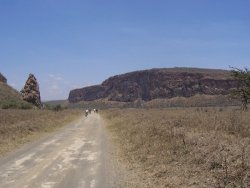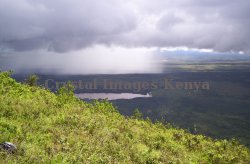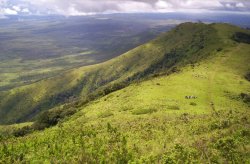|
TOURISM
IN KENYA
Great
Rift Valley >
Beautiful
countryside
Hotels
& Lodges
Kenya's
Coast
Economy
Government
Kenya
National
Parks
Lake
Victoria
The
People of Kenya
Wildlife

Most of the Rift Valley floor is dry, as seen
above.

Hiking on the Rift Valley escarpments is a
popular activity.

View of a lake on the Rift Valley floor.

Part of the Rift Valley escarpment west of the city of Nairobi.
LINKS
|
The Great Rift
Valley system,
as it cuts across Kenya’s
surface, is a wonder to behold with towering mountains dominating the
skyline, and numerous small lakes lying all over the valley floor.
Geological phenomena associated with the formation of the Rift Valley
also spawned the Kenya highlands, whose fertile soils and pleasant,
temperate climate have attracted settlers. The Kenya highlands, west
and east of the Rift Valley account for most of the country’s
agricultural output.
Its hardly surprising that in the early 20th century, European settlers
made for themselves a home in the area. Their lifestyles, far from the
moral constraints back home, gave rise to the term, “Happy Valley”.
The Rift Valley’s massive escarpments on either side display varying
environmental attributes. The Mau Escarpment on the west and the
Aberdare Ranges on the east are heavily forested mountain ranges. They
attract almost year round rainfall, resulting in numerous rivers that
have sustained life for thousands of years.
Other escarpments, especially to the dry north of the country are
rocky, almost vertical features. Towards the south, the escarpments are
not as imposing as those that are further north. The Nairobi – Nakuru
highway, one of the nation’s most important, veers across the Kikuyu
Escarpment at an altitude of 9000ft (2600
metres).
The Rift Valley lakes are fed by rivers flowing from the highlands and
mountains around it. Lake
Turkana, in Northern Kenya, is an alkaline lake with the world’s
heaviest concentration of Nile crocodiles. The area around Lake Turkana
is an important archaeological site in the study of human origins.
The central Rift Valley floor holds several small lakes, created by
faulting in the earth’s surface. Lake Naivasha is the most important
fresh water lake supporting fishing and agriculture. Other lakes
include Lakes
Nakuru, Elmenteita, Magadi, Baringo, Bogoria and Ol-Bolossat, all of
which have attracted various species of wildlife. Lake Nakuru’s unique
blend of alkaline waters is home to millions of flamingo birds.
Mountains in and around the Rift Valley, with thick forest, can be
conquered by anyone in good physical condition. As you climb natural
edifices such as Mt Longonot and Mt Kenya, you will come across
monkeys, gazelles, buffalo, tracks made by elephants and plenty of
birds nesting high in the trees.
Socio-economic activities in the Rift Valley region can be of great
interest. Witness pyrethrum farming, ranching, dairy farming, tea and
maize plantations. Camp on the shores of Lakes
Naivasha, Nakuru and Baringo and even indulge in a bit of sailing!
Top
|







